The Hessian The kitchen is strongly dominated by the center of Frankfurt with its well-known dishes, such as the Frankfurt sausages. But if you leave the metropolis and go to the country, you will find many local specialties of the Hessian cuisine. The cuisine in Hesse is very different, in North Hesse with its barren soil, people used to try to make the best of potatoes, often in combination with apples. In the sun-pampered South Hesse, new fashions were tried out that the traveling merchants brought with them. Hessen is also known for its drink, the Äpplwoi, nowhere else in Germany is so much cider drunk.
dishes
- Flurgönder with nudes (dialect: Schwoarte-Gönder) is one Fuldaer Specialty, a raw, smoked rind stomach in the shape of a bubble, which is cooked and eaten with ribbon noodles.
- Frankfurt ribs are also only called Ribs or as Rippli designated. The cured and cooked pork ribs are eaten warm with sauerkraut and mashed potatoes or bread, but sometimes also served cold with bread, rolls or potato salad.
- Kassler or Kasseler ribs, pork chops, etc. is a cured and lightly smoked piece of pork. The name has nothing to do with the city of Kassel, as one might think. There are various theories about where the name came from. The pork ribs get their name from the Hebrew (cashier or Yiddish chaser means pig. Another theory is that Kasseler comes from Kasserolle and may have been introduced with the Huguenots. According to a third theory, the term comes from a Berlin butcher named Cassel. The Kassler pork is still eaten in Hessen with pleasure.

Three types of Flurgönder

Frankfurt ribs with cabbage, mashed potatoes and mustard
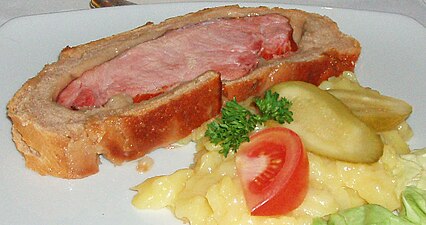
Kassler in bread dough with potato salad
- Duck fat is a North Hessian specialty that consists of bacon, sour cream or canned milk, onions and salt. Leave out the bacon, add sour cream and onions, season with salt. Jacket potatoes or dumplings are eaten as a side dish.
Potato dishes
In northern Hesse, the low soil quality was particularly suitable for growing potatoes, which led to a traditional potato kitchen. Even today, the potato is still particularly important in Hesse.
- Bump, also Rascals called, are sausage-shaped potato rolls, made from raw and cooked grated potatoes in linen bags. Jerky meat, black pudding or bacon is added to the potato mixture. The bumps are served with onion sauce.
- Thief are potato dumplings filled with Ahler Wurscht.
- Schepperlinge are a specialty in Waldecker Land. It's a kind of potato pancake made from flour, milk, sugar and yeast. Pressed potatoes, eggs and a pinch of salt are then worked into this yeast dough using a press. The mass is then baked light brown in portions and served with bacon, onions and black coffee.
- Potato pancakes with apple compote. finely grated potatoes and onions, egg, flour are formed into a dough and baked in a pan with fat and then eaten with apple compote.
Green Sauce
The Green Sauce was probably brought to Hesse by the Huguenots when they fled France at the end of the 17th century and was with them as Sauce verte known. The first printed recipe for the Frankfurt variant comes from Wilhelmine Rührig's cookbook in 1860. Today, green sauce is the Hessian classic for Easter and traditional food on Maundy Thursday and Good Friday, as well as for the holiday brunch.
- Frankfurter Green Sauce, Semolina sauce, is a cold herb sauce that is prepared on the basis of sour cream and sour cream or mayonnaise. The green color comes from the seven herbs, borage, chervil, cress, parsley, pimpinelle, sorrel and chives, which are traditionally added and cut as small as possible, often turned through a meat grinder to achieve the greenest possible coloration of the sauce. Eggs are usually halved in the South Hessian variant, but there are many different variants.
Frankfurt green sauce with boiled eggs and potatoes
The seven herbs (from top left): borage, lemon balm, sorrel, pimpinelle with blossom, parsley, chives with blossom, chervil
- For North Hessians Green Sauce The herbs parsley, borage, chives, sorrel, pimpinelle and, unlike the Frankfurt variant, dill and lemon balm are used. Another distinguishing feature is that in Northern Hesse the herbs are only roughly cut with a knife and the green color is only weakly mixed with the sour cream. In the North Hessian variant, eggs are crushed and mixed in.
North Hessian green sauce with jacket potatoes
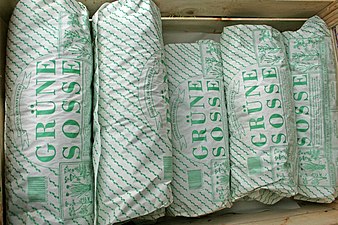
Packaged Frankfurt green sauce herbs, photographed at the Marburg weekly market
Johann Wolfgang von Goethe is also said to have been a big fan of the green sauce. According to Goethe aficionados, the herbal mixture came to Frankfurt much later. Nonetheless, it is on the packaging Goethe's favorite dish! to read.
sausage
- Frankfurters. The well-known thin scalded sausage made from pure pork, which gets its special aroma through a special smoking process. The sausages are not boiled, just warmed up in hot water. They are eaten in pairs with horseradish or mustard and bread or potato salad. The name is protected in Germany and may only be used for sausages that were produced in the Frankfurt am Main area.
- Frankfurt beef sausage is a hot smoked scalded sausage made from 100% beef.
- Frankfurt zeppelin sausage is a coarse liver sausage that has been produced in Frankfurt am Main since 1909. It is now a registered trademark.
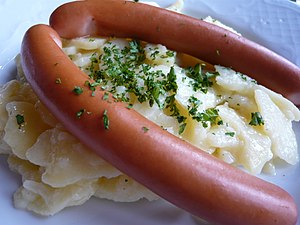
Frankfurter sausages with potato salad

Frankfurt beef sausage on the grill

Zeppelin sausage
- Ahle Worscht is a kind of traditional salami in Northern Hesse that is both smoked and air-dried.
- Alarm clock In Northern Hesse and in Eichsfeld there is the sausage specialty Weckewerk or Wake-up sausage. It is made from boiled rinds and minced pork and meat or sausage broth. In some cases, cooked pieces of meat, blood or offal are also processed. The peculiarity is that the sausage is stretched with stale rolls, hence the name, “Wecke” is the traditional name for the rolls in Northern Hesse. The ingredients rolled through the meat grinder are eaten immediately or filled into pork intestines (wake sausage). To make the sausage more durable, it is cooked in large-caliber artificial casings or preserved in jars. Weckewerk is fried in the pan or eaten cold. Jacket potatoes, pickled cucumber, beetroot or green salad with sour cream sauce are popular side dishes. A former mayor of Kassel almost liked the wake-up work, and this method of preparation has been used ever since Mayor style called.
- Rind stomach is a sausage made from pork and pork rind. In other areas it is called press head, press sack or press sausage. Veal and / or pork are cut into coarse cubes with pork rind, plus ground rind with broth and white wine and, if necessary, aspic powder. The mass is filled into artificial casings or filled into cans and then cooked.
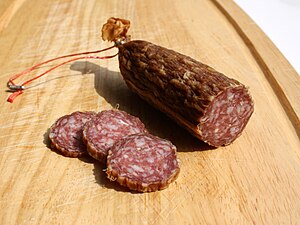
Awl sausage
Alarm clock with potatoes and pickles

Rind stomach in a can
- The name of the Kassel ribs or just Kassler has nothing to do with the city of Kassel. The pork ribs probably got their name from Yiddish chaser = Pig, or from Hebrew cashier. A Berlin butcher is said to have invented it before 1880.
Pastries
- A Ploatz,Plootz or Schmirchelskuche, is generally a salty / sweet yeast pastry, a sheet cake made from rye bread dough with different toppings.
- Speckkuchen is a sourdough rye bread dough rolled out on a baking sheet on which a mixture of sour cream, eggs, leek and pieces of bacon sprinkled with breadcrumbs is spread and then baked in the oven. In Northern Hesse, on baking days, it was pushed into the oven of the village communities after bread. It is popular as a quick snack at food stalls or in bakeries and in the country at events such as the fair.
- Onioncake is a hearty cake that is named after its main topping, the onions, and is especially eaten with fresh apple cider.

Plootz
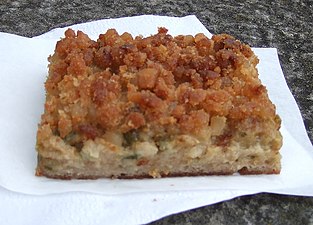
North Hessian bacon cake
Onioncake
Sweets
- Frankfurt wreath is a wreath-shaped buttercream cake that consists of several bases and is filled with buttercream. The outside is coated with buttercream and sprinkled with brittle made from almonds, hazelnuts or walnuts.
- Haddekuche (Hard cake) is a diamond-shaped gingerbread, covered with a diamond pattern, which is produced in Frankfurt and southern Hesse. Its name probably comes from the fact that it dries quickly and then becomes hard. The Haddekuche is eaten like this or sprinkled with coarse sugar crystals. But it can also be used as a sauce gingerbread to thicken sauces.
- Bethmännchen are made from a marzipan dough made from ground almonds, powdered sugar and rose water. Small balls are formed, decorated with three halved almonds, coated with egg yolk and then baked.
- Frankfurt Brenten are a tea biscuit specialty that has been made in Frankfurt since the Middle Ages. They are made from a marzipan dough that does not use flour and is replaced by sugar or honey. The finished dough is shaped into wooden molds and baked in the oven.
Frankfurt wreath

Haddekuche
.jpg/262px-Bethmaennchen_(cropped).jpg)
Bethmännchen

Frankfurt Brenten
- Kassler chunks are a popular pastry in Kassel. Bisquit crumbs, raisins, nuts and rum are processed into a stable mass, shaped into a cone, coated with chocolate and chilled, done.
- Offenbach pepper nuts were world famous since the 18th century, until 1980 the state of Hesse served pepper nuts at state receptions, after which they were forgotten. Since 2014 they are in the tourist information and in some cafes in Offenbach am Main available again. It is a light and soft cookie that is seasoned with pepper, nutmeg, coriander and cinnamon.
- Crepe Baked yeast dough balls in fat and filled with jam
ingredients
cheese
- Hand cheese is a sour milk cheese made from low-fat quark, baking soda and salt. Outside Hesse he is also known as that Harzer, or Harz roller known. Its fat content is less than one percent. It is often eaten with music, a traditional marinade made from onions, vinegar and oil, pepper and salt. Usually you eat the hand cheese without a fork, only with a knife. Small pieces are cut off, placed on the bread and then bitten by the bread.
- Cooked cheese is made from quark. The quark that has drained off is mixed with baking soda and, after a period of rest, heated while stirring until it liquefies. The viscous mass is mixed with butter and egg yolk and seasoned with salt and caraway seeds. The cooked cheese comes with or without music (see above) eaten on bread.
- Spund cheese is a cream cheese preparation from northern Rheinhessen. It is eaten either as a dip or as a spread.
from left to right: Kochkäs, Spundekäs and Handkäs with music
Hand cheese with music

Cooking cheese with music

Spund cheese with pretzels
beverages
Hardly any other German area offers this variety of drinks. Beer and wine are served side by side, cider is widespread, sparkling wine also comes from the area and there are also distilleries.
Cider
The typical drink around Frankfurt is apple wine, Ebbelwoi. It is usually made from a special cider glass, the Geribbde, drank. It is often served in the Bembel, a pot-bellied stoneware jug in gray with a blue pattern. The size of the Bembel is determined by the number of Schöbbsche indicated, e.g. 4-piece bembel. A Schöbbsche was originally 0.3 l, today 0.25 l is often served.
The apple cider has three phases. First it's a cutie pie, an unfermented apple cider without alcohol. Then he becomes the Rauscher, in the middle of the fermentation there is already alcohol, but you can hardly taste it, so be careful when drinking. Finally, after successful fermentation, a clear, light yellow drink with a tart-sour taste was created, that of Hesse Stöffche, or also Age is called.
Apple cider can also be used as a G'spritzde drink, then mineral water is added. If you have a Sweet-G'spritzde ordered, you get a cider mixed with lemon lemonade or orange lemonade. It can happen when you order a sweet spritzed drink in the traditional cider bars in Sachsenhausen or Bornheim that you incur the anger of the staff. Adding lemonade destroys the taste and character of the apple wine. Many of these restaurants still press their own cider and are proud of their product. You still admit that Ebbelwoi Dilute with water, but sweeten it, that goes too far. In such cases, cider and lemonade are also served separately, so the guest can mix them himself.
Apple wine is also mixed with cola, which is called "Appelwein-Cola" or "Zitsch". In the Frankfurt area it is also referred to as "Korea" and in the Hessian Ried as "KE", which stands for Kola-Ebbelwoi.
Apple cider in a typical ribbed glass

Apple cider with bembel and ribs
Wine
In Hesse, wine is also made from grapes. There are the wine-growing regions Rheingau and Hessische Bergstrasse.
To the Hessian wine-growing region Rheingau count the following places. Not all of them are actually in the Rheingau.
It becomes predominantly the white grape variety Riesling cultivated and by far the red variety Pinot Noir.
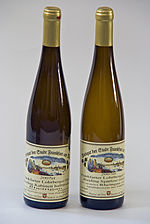
Riesling Kabinett and Spätlese
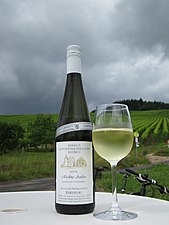
Riesling selection
The wine region Hessian mountain road lies on the western slope of the Odenwaldes to Upper Rhine Plain down. The following places belong to the wine-growing region.
With a share of over 50%, the Riesling most common grape variety followed by Müller-Thurgau and Pinot Gris. Only one eighth of the cultivation are red wines, especially with the varieties Pinot Noir, Dornfelder and St. Laurent.

Grapevines in autumn on the mountain road

Barrel cellar of the Hessian State Winery Kloster Eberbach
The Hessian State Winery Eberbach Monastery is the largest winery in Germany with 200 hectares of cultivation area. It extends over cultivation areas in the Rheingau and the Hessian Bergstrasse.
sparkling wine
Hessen is the second largest producer of sparkling wine in Germany after Rhineland-Palatinate. In a triangle between Eltville, Wiesbaden and Hochheim are the most famous of the German sparkling wine manufacturers, such as Henkell, Fürst von Metternich, Matheus Müller (MM), etc.
In many sparkling wine cellars, guided tours are offered, during which knowledge about the production of the sparkling drink is imparted. Of course, you can also taste it.
Brandy
Hugo Asbach coined the term brandy in 1919 after it was banned in Germany to distill cognac. Good drinking wines are not always suitable for making a good brandy. Although the distilleries are located in the middle of the wine-growing region, they like to fall back on special wines from France or Italy.
The colorless distillate must first be stored in oak barrels in order to become a good brandy. For barrels less than 1000 liters, at least 3 months, for larger barrels at least 6 months.
The most famous brand name is likely to be Asbach ancient sein, the oldest German manufacturer of brandy based in Rüdesheim am Rhein. Another very well known brandy is Chantré from Eltville am Rhein. However, there are many smaller distilleries that also produce brandy from local grapes.
Schnapps and liqueurs
beer
In the ranking of the German federal states, Hessen ranks 4th with 62 breweries. There are the well-known, supraregional producers Licher and Binding, but also a variety of small local breweries.
Soft drinks
- After the apple harvest, the natural, freshly squeezed apple juice, which can certainly stimulate the intestinal activity, is popular in autumn.
Culinary calendar
Culinary delights are often seasonal. Fruits and vegetables are tastier when they are ripe; meat and fish are also subject to seasonal influences. Every season of the year, festivals are celebrated that have a general theme or focus on certain foods. There are also drinking and eating habits throughout the year that arose from religious traditions such as fasting times.
January
- Everyone is talking about them at carnival or carnival time, Crepe, elsewhere they are called donuts or donuts. The sweet, filled pastries are available in almost all bakeries.
February
- The International Marburg Soup Festival with tasting usually takes place on a Saturday from 5:00 p.m. to 7:00 p.m. in mid-February to the end of February Marburg Richtsberg district. Private individuals and associations compete for the best soup, which is selected by a jury.
- It will be at the end of February and beginning of March Rheingau Gourmet & Wine Festival held on 18 festival days. There are events with celebrity chefs and wineries from all over the world.
March
April
- The Asparagus season starts at the beginning of April, depending on the soil temperature
- Traditionally on April 23rd the Day of the beer celebrated, because on this day in 1516 the German purity law was proclaimed. There are events on the topic of beer in many places (German Brewers Association).
- The Rheingau gourmet weeks will be between Flörsheim am Main and Lorch on the Rhine organized from the last Friday in April to the 1st Sunday in May. The wine-culinary season opening in the Rheingau is celebrated with a variety of events in wineries, taverns and restaurants.
May
- Asparagus season
- On May 1st one of the young winemakers will Vineyard hike organized. It leads through the vineyards of Zwingenberg until after Heppenheim, or the other way around. Over a length of around 21 km there are eight supply stations with food and tasting stands for the local winegrowers who supply the 30,000 to 40,000 hikers.
- In Zwingenberg the Wine market held on the historic market square on the weekend of Pentecost.
June
- The Asparagus season ends on Midsummer Day, June 24th.
- The Odenwald Lamb Weeks are held in the second half of June. The participating inns offer lamb dishes exclusively Odenwald Shepherds.
July
August
- In the first half of August, the Hauptwache in Frankfurt am Main the Cider festival hosted. The celebration is from Sunday to Thursday 11 a.m. - 11 p.m. and Friday and Saturday 11 a.m. - midnight, with a stage program, cider made from old apple varieties, trendy mixed drinks and cocktails with cider.
September
- In Bensheim a winegrowers festival takes place on the first weekend in September
- In Groß-Umstadt the annual wine festival is held on the first weekend after September 15th
October
November
- Around St. Martin's Day on November 11th, goose dishes are offered as traditional St. Martin's goose food in many inns.
December
literature
Recipes
If you want to enjoy Hessian cuisine at home, you will find the appropriate recipes in Koch Wiki under Category: Hessian cuisine. Have fun cooking at home.









.JPG/300px-Grune_Sosse_(Nordhessisch).JPG)























.jpg/262px-Bethmaennchen_(cropped).jpg)













